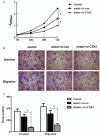Tumor-suppressor microRNA-139-5p restrains bladder cancer cell line ECV-304 properties via targeting Connexin 43
- PMID: 31567382
- PMCID: PMC6819043
- DOI: 10.1097/CM9.0000000000000455
Tumor-suppressor microRNA-139-5p restrains bladder cancer cell line ECV-304 properties via targeting Connexin 43
Abstract
Background: In our previous paper, we demonstrated that Connexin 43 (CX43) was highly expressed in bladder cancer (BC) tissues. But the molecular mechanism about microRNAs (miRNAs) regulation upstream of CX43 in BC has not been well elucidated and remains to be further studied. MicroRNA-139-5p (miR-139-5p) is a tumor suppressor in progression of multifarious cancers including BC. Nevertheless, the underlying mechanisms of CX43/miR-139-5p in tumorigenesis of BC are still not well illustrated. The specific objective of our study was to inquiry the effect of CX43/miR-139-5p on BC progression and its underlying mechanism.
Methods: The bioinformatics analysis softwares were applied to predict the miRNAs in the upstream of CX43. First, the expression levels of miR-139-5p in BC tissues (tumor) and paracancer tissues (normal) were investigated using the data from The Cancer Genome Atlas database. Quantitative reverse transcription-polymerase chain reaction (qRT-PCR) was used to detect the mRNA expression level of miR-139-5p in three human BC cell lines 5637, T24, ECV-304 and a human bladder epithelial immortalized cell line SV-HUC-1 (normal control). Then si-CX43, si-control, miR-139-5p mimic, and its negative control (NC) were transfected into BC cell line ECV-304. The relationship of miR-139-5p and CX43 was analyzed by dual-luciferase reporter assay. The qRT-PCR and Western blotting were used to test the mRNA and protein expression level of CX43. The proliferation of ECV-304 and T24 cells were examined by cell counting kit-8. The migration and invasion of ECV-304 cells were tested by transwell assay. To determine whether miR-139-5p would affect cell proliferation, migration and invasion by targeting CX43, we executed the rescue assay. The comparison between two groups was analyzed by Student's t test, and comparisons among multiple samples were performed by one-way analysis of variance and a Bonferroni post hoc test.
Results: The expression of miR-139-5p was remarkably down-regulated in BC tissues (tumor vs. normal, 2.286 ± 0.017 vs. 3.211 ± 0.034, t = 11.540, P < 0.0001) and cell lines (P < 0.01 in all BC cell lines). Besides, we also indicated that over-expression of miR-139-5p reduced the proliferation of ECV-304 (P = 0.001) and T24 cells (P = 0.005). Moreover, miR-139-5p over-expression weakened the invasion (P = 0.001) and migration (P = 0.001) of ECV-304 cells. Furthermore, the relative luciferase activity of CX43-wild type construct was distinctly lessened by up-regulation of miR-139-5p (miR-139-5p mimic NC vs. miR-139-5p mimic, 0.916 ± 0.063 vs. 0.356 ± 0.048, t = 7.085, P = 0.002), nevertheless the activity of CX43-mutant type construct was untouched (miR-139-5p mimic NC vs. miR-139-5p mimic, 0.918 ± 0.057 vs. 0.878 ± 0.039, t = 0.577, P = 0.595). Finally, the rescue assay revealed that CX43 deletion enhanced the depressor effect of miR-139-5p on ECV-304 cell proliferation (P < 0.01), invasion (P = 0.028), and migration (P = 0.014).
Conclusion: MiR-139-5p, as a tumor-suppressor, repressed cell proliferation, invasion, and migration in BC, which might be achieved by regulating CX43.
Figures





References
-
- Bray F, Ferlay J, Soerjomataram I, Siegel RL, Torre LA, Jemal A. Global cancer statistics 2018: GLOBOCAN estimates of incidence and mortality worldwide for 36 cancers in 185 countries. CA Cancer J Clin 2018; 68:394–424. doi: 10.3322/caac.21492. - PubMed
-
- Powles T, Al E. MPDL3280A (anti-PD-L1) treatment leads to clinical activity in metastatic bladder cancer. Nature 2014; 194:558–562. doi: 10.1016/j.juro.2015.07.017. - PubMed
-
- Wu Y-T, Chang H-M, Huang H-F, Sheng J-Z, Leung PCK. Bone morphogenetic protein 2 regulates cell–cell communication by down-regulating connexin43 expression in luteinized human granulosa cells. Mol Hum Reprod 2016; 23:155–165. doi: 10.1093/molehr/gaw078. - PubMed
-
- Ai XL, Chi Q, Qiu Y, Li HY, Li DJ, Wang JX, et al. Gap junction protein connexin43 deregulation contributes to bladder carcinogenesis via targeting MAPK pathway. Mol Cell Biochem 2017; 428:109–118. doi: 10.1007/s11010-016-2921-9. - PubMed
MeSH terms
Substances
LinkOut - more resources
Full Text Sources
Medical

